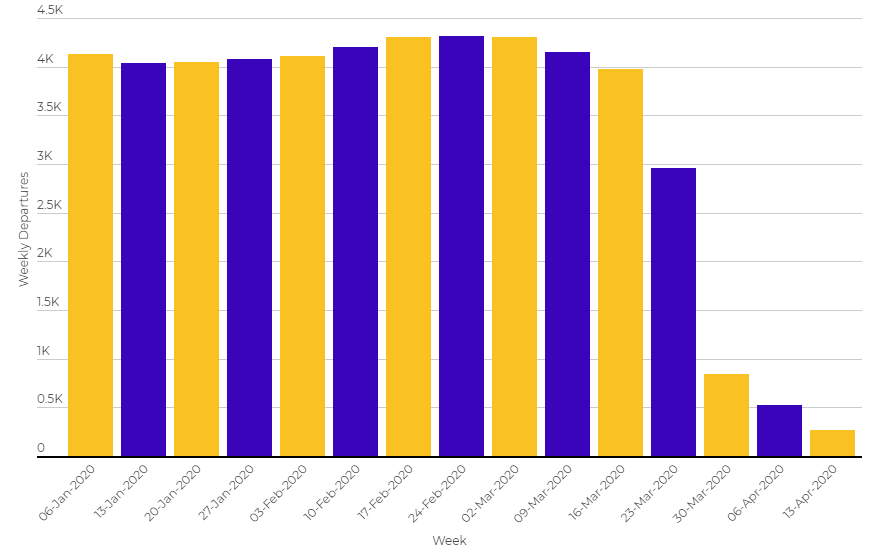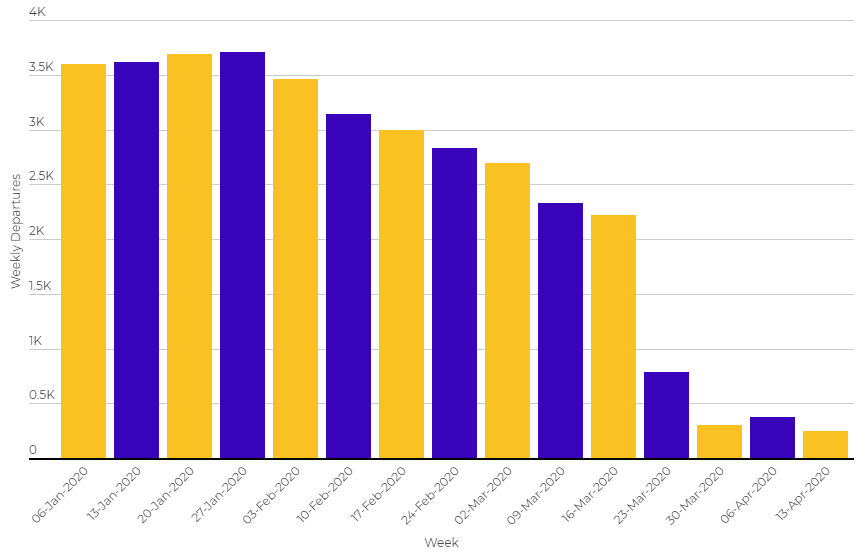Right now, with global capacity down to less than one third the levels recorded last year, those figures seem a long way off. But, while it may take airports a long time to introduce new capacity, that can quickly reduce it.
As air passenger demand has collapsed, driven by declining public confidence and stringent travel restrictions, some airports have already closed, others or providing an on demand ad hoc service for any flight arrivals. Some have even accelerated works projects so they can be completed during the current quiet period and not disrupt passengers when demand increases.
Amsterdam Schiphol Airport and Singapore Changi Airport - both award winning hub airports - provide excellent examples of how international air gateways are having to quickly adapt to reduce capacity - and importantly, costs - as passenger demand hits new lows.
Amsterdam Schiphol Airport is continuing its 'Core Schiphol' programme to reduce its operations in response to the effects of the downturn in travel. As global travel shuts down to the bare minimum requirements to repatriate citizens and move cargo, so airports are reducing operations to match.
Schiphol has now shut down five of its piers (B, C, F, G, H), keeping just two open (D and E) with the rest being used to park aircraft. From 27-Mar-2020 departure check-ins have been limited to Departures 2 and 3 with Schengen travellers passing through one dedicated security check, and others through a different one. Social distancing measures have also been adopted.
Miriam Hoekstra-van der Deen, director of airport operations, said: "There were only around 5% of travellers and 10% of flight movements in recent days, when compared to the same period last year. Our operations have shrunk, but we always remain open. That way, people can get home and things like fruit, vegetables and medical supplies can get to their destinations".
CHART - Amsterdam Schiphol has seen scheduled passenger flights decrease from a high of over 4,300 weekly departures at the beginning of Mar-2020 to a low of under 275 just six weeks later in Apr-2020 Source: The Blue Swan Daily and OAG (data: w/c 13-Apr-2020)
Source: The Blue Swan Daily and OAG (data: w/c 13-Apr-2020)
Scaling back started in March when flight operations first started decreasing. At first Schiphol handled a lot of flights that were handling repatriation of Dutch citizens, freight traffic, emergency services and diverted flights. Operations were further scaled back during March and into April.
Just a matter of weeks ago, Amsterdam Schiphol was handling some 1.5 million passenger seats a week, placing it around 8th in the world's busiest airports rankings, now that has dropped to 103rd place, with just 183,000 seats a week, a reduction of -88%.
In place of passenger services, cargo has now become a much more important part of the airport's operations. In the past some 250 cargo flights a week operated at Schiphol but that has now increased to 360 with passenger flight slots now being used for cargo services. Medical equipment used to make up 4% of cargo at Schiphol but that has now increased as the need for face masks and other medical equipment escalates.
With the steep decline in passenger traffic due to COVID-19 continuing, Changi Airport Group (CAG) is one of many airports that have announced that it will be closing down terminals to consolidate operations. From 1-May-2020 Changi's T2 will be closed for 18 months with all airlines relocated to the remaining terminals. The closure will then permit the planned expansion works to be brought forward by up to a year from the scheduled completion of 2024.
CHART - Singapore Changi Airport has seen scheduled passenger flights decrease in a slow stepped pattern during Feb-2020 and Mar-2020 before dropping suddenly in late Mar-2020 and through Apr-2020 Source: The Blue Swan Daily and OAG (data: w/c 13-Apr-2020)
Source: The Blue Swan Daily and OAG (data: w/c 13-Apr-2020)
Among the airlines operating at T2 who will be moved to T3 are Singapore Airlines, United Airlines, Ethiopian Airlines, Etihad Airways, All Nippon Airways, Malaysia Airlines and Royal Brunei. A number of other airlines that normally operate to T2 have temporarily suspended all operations.
Operations at T4 are also being scaled back with only a small number of boarding gates being kept open and shops shut once the last flight has departed. If more airlines suspend flights then this terminal may also be closed until flights resume. In order to assist airport concessions because of the significantly reduced number of passengers travelling through the airport, CAG has waived all rentals for T4 concessions for two months from 24-Mar-2020.
Mr Tan Lye Teck, CAG's executive vice president of airport management said "the consolidation efforts seek to help our airport partners during this difficult time". "Even as our airport capacity is being optimised for the current situation, we will have the flexibility and we stand ready to ramp up operations quickly once the recovery takes place," he added.
Other airports closing terminals includes London Gatwick, which has closed the North Terminal, consolidating all services in the South Terminal. Across the other side of the UK capital, at Heathrow, Terminals 3 and 4 have closed this week with the flights of Cathay Pacific, Emirates Airline and Pakistan International Airlines moving temporarily to Terminal 2 .
Some airports have shut down altogether. This includes London City Airport which closed on 25-Mar-2020 and is expected to stay shut through Apr-2020 at least. Stuttgart Airport in Germany is taking the opportunity to bring forward planned runway resurfacing work.
The work had been planned but has been brought forward to 6-Apr-2020 to mid Jun-2020, when all operations will be suspended in the first phase. The second phase will be from 23-Apr-2020 to 20-May-2020 when a 1965 metre section of the runway will be available for use by cargo and emergency flights.
Stuttgart Airport officials confirm that a further section will be added from 21-May-2020 and then full operations will then be resumed on 18-Jun-2020. The way things are looking that will be before we really start to see any uptick in demand.